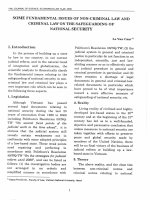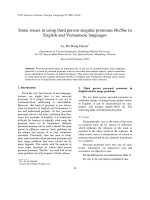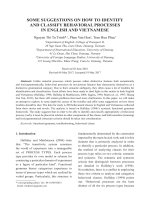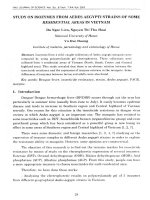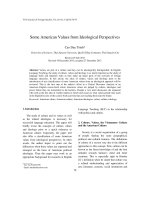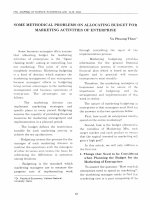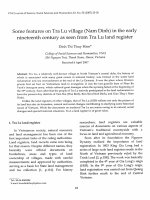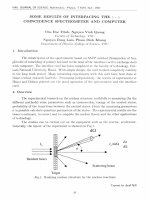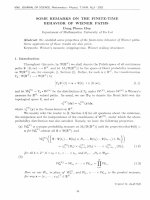DSpace at VNU: Some American Values from Ideological Perspectives
Bạn đang xem bản rút gọn của tài liệu. Xem và tải ngay bản đầy đủ của tài liệu tại đây (168.13 KB, 9 trang )
VNU Journal of Foreign Studies, Vol. 29, No. 4 (2013) 70-78
Some American Values from Ideological Perspectives
Cao Duy Trinh*
University of Sciences, Thai Nguyen University, Quyết Thắng Commune, Thái Nguyên City
Received 9 July 2013
Revised 19 December 2013; accepted 27 December 2013
Abstract: Values are part of a culture and they can be ideologically distinguished. In English
Language Teaching, the study of culture, values and ideology is as much important as the study of
language skills and linguistic rules as they make up major parts of the curricula of foreign
language education. In this article, the ideas of culture, values and ideology prior to the
introduction of my classification of some American values from an ideological approach will be
reviewed. This is the first step of the author’s effort in a Critical Discourse Analysis of an
American English course-book where American values are judged by culture, ideologies and
power before they are transmitted to the learners. Despite a very short discussion, the argument
will work as the key idea of further studies in which such issues as what values people may teach
in the English lessons of this course-book and why they are teaching them must be found.
Keywords: American values, American culture, American ideologies, values, culture, ideology.
1. Introduction*
Language Teaching (ELT) in the relationship
with politics and culture.
The study of culture and its values as well
as the related ideologies is necessary for
successful language education. This paper will
briefly revise the concepts of culture, values
and ideology prior to a quick reference to
American culture. Especially, the paper will
also offer a classification of some American
values from ideological perspectives. In other
words, the author hopes to point out the
differences when these values are separated and
arranged on the basis of American political
ideologies. Then this paper may work as an
appropriate background for research on English
2. Culture, Values, the Vietnamese Culture
and the American Culture
Society is a social organization of a group
of people sharing the same geographical,
political and cultural features. The definitions
of culture of a society vary due to the different
approaches to this concept. First, culture can be
known as the finest knowledge of and the best
attitudes towards human’s mind and heart
creations. This is especially right in Hornby
[1]’s definition when he stated that culture was
a refined understanding and appreciation of
arts, literature, customs, social institutions and
_______
*
Tel.: 84-912621599
Email:
70
C.D. Trinh / VNU Journal of Foreign Studies, Vol. 29, No. 4 (2013) 70-78
so on of a particular group or people. Secondly,
in everyday life, culture can be simply
understood as people’s habits, their behaviors
and ways of life. In fact, people live in different
places, speak their languages, eat certain foods
and vote for the people they trust in their own
ways. These people enjoy certain literature
works, some pieces of music or specific kind of
amusements and do their jobs in their routines.
That is their culture. The culture of a society
can be abstract or concrete: it is tangible and
intangible, ranging from the enamels of the
ancestors’ potteries to the respect of a wife
towards a husband in an Asian country. The
examples of cultures can be the cultures of
Vietnam, the Middle East or the Western
nations.
So, what really makes up a culture for it to
play such an important role? Samovar et al. [2]
assumed that culture has subjective elements
such as: “…values, attitudes, beliefs,
orientations, and underlying assumptions
prevalent among people in a society…the
subjective cultural beliefs and values you hold
that influence your interpretation of the world
and the interaction in it. Your view about
American flag, work imagination, freedom, age,
ethics, dress, property rights, etiquette, healing
and health, death and mourning, play, law,
individualism, magic and superstition, modesty,
sex, status differentiation, courtship, formality
and informality, bodily adornment, and the like
are all part of your cultural membership.”
With a view to providing an all-over
structure of culture, Tomalin & Stempleski [3]
showed that culture comprises of cultural
products, ideas and behaviors, which, in turn
consist of other cultural elements, as shown in
the figure. The cultural products include
literature, folklore, art, music, and artifacts. The
cultural behaviors comprise customs, habits,
71
dress, foods and leisure. Especially, the cultural
ideas contain beliefs, values and institutions as
elements.
Elements of culture
Anyway, culture can be about more than the
elements in the above model. In the book
“Communication between Cultures”, Samovar
et al. [2] mentioned other cultural components:
cultural worldview with explanations of life and
death; culture and the individual with cultural
identity; alternative views of reality with
cultural values; words and meaning with
language
and
culture;
non-verbal
communication with the messages of action,
space, time and silence; cultural influence in
context with the business setting, the
educational setting and the healthcare setting.
They assumed that culture has its own
characteristics: it is learned, shared and
transmitted from generation to generation.
According to these scholars [2], it is family,
community and religion that initially make up a
culture: “…family, community (country) and
worldview (religion) were three of the earliest
markers in the evolution of what we now call
culture.”
Values are essential particles in a culture.
We know that values and valuing are not new to
humans. Long in axiology or ethics in ancient
philosophy, people began to find out how, why
72
C. D. Trinh / VNU Journal of Foreign Studies, Vol. 29, No. 4 (2013) 70-78
and to what extent they should value a person,
an idea, an object or something else. Value
theory deals empirically with what people value
and why they value it in psychological, social
and economic contexts. People always try to
understand about good and evil.
Aspin [4] took values as standards for
judgments and decisions: “ to refer to those
ideas, conventions, principles, rules, objects,
products, activities, practices, procedures or
judgments that people accept, agree to, treasure,
cherish, prefer, incline towards, see as
important and indeed act upon. Such things
they make objects of admiration, high levels of
aspiration, standards of judgment, prescriptions
for action, norms of conduct or goals of
endeavor in their lives seeing them as generally
prescriptive in all their values reflection and
decisions, and they commend them so to
others.”
The above statement goes well with Leo’s
idea [5] that values can influence us in our
careers or in our lives: “Values are ideals that
guide or qualify your personal conduct,
interaction with others, and involvement in your
career. Like morals, they help you to
distinguish what is right from what is wrong
and inform you on how you can conduct your
life in a meaningful way.”
As for Rokeach [6], values are either “a
learned organization of rules for making
choices and resolving conflicts”. Nanda and
Warm [7] see them as “shared ideas about what
is true, right, and beautiful that underlie cultural
patterns and guide society in response to the
physical and social environment”. Samovar et
al. [2] mentioned Albert’s highlighting of the
significance of values: “a value system
represents what is expected or hoped for,
required or forbidden. It is not a report of actual
conduct but the system of criteria by which
conduct is judged and sanctions applied.”
These scholars also noted Hofstede’s short list
of value counter pairs:
-
Evil versus good
-
Dirty versus clean
-
Dangerous versus safe
-
Decent versus indecent
-
Ugly versus beautiful
-
Unnatural versus natural
-
Abnormal versus normal
-
Paradoxical versus logical
-
Irrational versus rational
-
Moral versus immoral
According to Leo [8], values are of four
kinds: personal values, cultural values, social
values and work values. First, he stated that
personal values, such as honesty, reliability, and
trust, determine how you would face the world
and relate with people. These values would act
as principles that define you as an individual.
He provided some examples of these values like
caring, courage, creativity, friendliness,
honesty, honor, and independent. The other
values, cultural values would help you feel
connected to a larger community of people with
similar backgrounds. They are like the practice
of your faith and customs, like the principles
that sustain connections with your cultural
roots. Tradition, faith, linguistics are the
sources of some cultural values. Thirdly, Leo
mentioned family, friends, and co-workers as
related indicators of social values, the principles
that show how you relate meaningfully to
others in social situations. Examples of these
values are equality, fairness, reliability, family,
environment, diversity and so on. Finally, what
define how you work and how you relate to
your co-workers, bosses, and clients are the
C.D. Trinh / VNU Journal of Foreign Studies, Vol. 29, No. 4 (2013) 70-78
work values, the principles guiding your
behavior in professional contexts and revealing
your potential for advancement. Autonomy,
competitiveness, conscientiousness, dedication,
loyalty, punctuality, teamwork could be in the
list of work values. The distinction also tells us
of the natural differences between an
individual, a culture, a society and the earning
of our living with work. Leo thought that for
certain aspects of life, humans have certain
values respectively.
Much influenced by Buddhism from India
and Confucianism from China, Vietnamese
culture is well known for its traditional cultural
values such as loyalty, formality, intelligence,
bravery, trustworthiness, forgiveness, diligence.
They show respect for community and family,
handicrafts and manual labor, devotion to study
and so on. The feudal society which lasted for
four thousand years, though having many shortcomings, has still given us a treasure of
kindness and creation. In addition, values of a
society have much to do with cultural and
politic assumptions and requirements. They
always go along with power and set standards
for us to strive for. The adoption of communism
and socialism also features the values of
Vietnam: the longing for the common benefits
of all the people and the share of the social
welfare and property between them.
American culture can be seen as a special
topic of interest in the teaching of American
English. The culture of the United States
originates from English, Scottish, Irish settlers
with their languages, legal system and other
cultural influences. A big influence is from
Western Europe (from German, France, Italy
etc.) with a long history before its own in
dialect, music, arts, social habits, cuisine, and
folklore etc. The USA is now, as many people
call it, a “melting pot” or “a salad bowl” with
73
cultural diversity from its immigrants. What
make the pride of the Americans are their
holidays,
sports,
military,
arts
and
entertainment. What include in American
society and culture are conservative tendencies,
military and scientific competitiveness, political
structures, risk taking, free expression, material
and moral lives. With the influence of whatever
made in the USA, American values sometimes
become standards for the young generations.
These American values are more or less
imposed on by American ideologies.
3. Ideology & the American Ideologies
The term ideology can be understood in
several ways. Ideology can mean everything –
values also, which is much related to politics
and power, and can be equal to commonsensical
assumptions of a group of people. In their book,
Thomas et al [9] showed that the concept of
ideology was first introduced by followers of
Karl Marx, notably Louis Althusser. Althusser
saw the majority of working people who
worked long hours and lived in poverty while
the rich enjoyed lives of luxury. They did not
overthrow the rich minority or refuse to work
for the rich because they were persuaded that
the situation was quite ‘natural’ and could not
be changed. Thus, the ideology had been
established – the beliefs people should hold
seemed such a common sense that nobody
would question it.
Today, ideology refers to any set of beliefs
which, to the people who hold them, appears to
be logical and natural. Ideology is not
necessarily a pejorative term, because it can be
argued that virtually everything we know and
think is in fact ideological/ideology in nature.
People can question the ideologies of their
74
C. D. Trinh / VNU Journal of Foreign Studies, Vol. 29, No. 4 (2013) 70-78
culture, but it is often difficult. Not only can it
be a challenging intellectual task, but it can also
result in social stigmata.
Fairclough [10] related ideology with
politics, specifically with power of dominant
classes and dominant blocs. For him, ideology
is: “Institutional practices which people draw
upon without thinking often embody
assumptions which directly or indirectly
legitimize existing power relations. Practices
which appear to be universal and
commonsensical can often be shown to
originate in the dominant class or dominant
bloc, and to become naturalized.”
Ideology, as for Johnston [11] is a biased
set of values that other people might have but
from which we ourselves are free. And we all
have our ideologies and we use them in dealing
with other people. Here, we can see that there is
a direct link between ideology and values. If the
attitude of social groups as a whole towards the
needs of other social groups in the society is
expressed through the ideas called ‘political
values’, we can use the word ‘ideology’ for
them, instead.
As for Halpin and Agne [12] for years in
the USA, traditional public opinion polling has
broken down ideology into three distinct
groupings: liberal, moderate, and conservative.
We also learn from Wikipedia [13] that, in the
United States, liberalism is different from
liberalism elsewhere in the world. Liberalism in
the United States centers on the rights of the
individual in speech, the press, and religion.
Liberalism respects the separation of church
and state, right to due process and equality
under the law. Modern liberalism in the United
States focuses on voting rights for adult
citizens, equal rights, protection of environment
and provision of social services in education,
health care, transportation, infrastructure, basic
food for the hungry and basic shelter for the
homeless. Some classical liberals, neoliberal or
libertarians think that economic freedom is
more important than equality of opportunity
and promoting general welfare of society
exceeds the legitimate role of government.
Since the 1930s, liberalism in the United States
has referred to "modern liberalism", a political
philosophy exemplified by Franklin Delano
Roosevelt's New Deal and, later, Lyndon
Johnson's Great Society.
American Conservatism mostly means
liberalism or neo-liberalism. It has been
associated with Republican Party since the
1950s. Many Southern Democrats were also
conservative when they controlled the Congress
during the period from 1937 to 1963.
According to Wikipeadia [14], the conservative
tradition has played a major role in American
politics and culture since the American
Revolution by the end of the 18th century.
American conservatives respect tradition,
support republicanism and Christian religion,
defend “Western civilization from the
challenges of modernist culture and totalitarian
governments”. Economic conservatives favor
small government, low taxes, limited
regulation, and free enterprise. Social
conservatives see traditional social values as
threatened by secularism; they tend to support
school prayer and oppose abortion and the
legalization
of
same-sex
marriage.
Neoconservatives want to expand American
ideals throughout the world and show a strong
support for Israel. Paleo-conservatives stand in
opposition to multiculturalism, and press for
restrictions on immigration. Most conservatives
prefer Republicans over Democrats, and most
factions favor a strong foreign policy, a strong
military. The conservative movement of the
C.D. Trinh / VNU Journal of Foreign Studies, Vol. 29, No. 4 (2013) 70-78
1950s attempted to bring together these
divergent strands, stressing the need for unity to
prevent the spread of "Godless Communism".
The American conservatives consider it their
jobs to have a centralized government to protect
its citizens’ lives, liberty and property. The
growth of government must be fought
relentlessly.
Rightness and righteousness
Ideologies can be the first and firm ground
for values. There is a strong connection
between what people should do and how they
should be. For example, they should devote to,
contribute to and scarify for their nation, and
thus, they should be honest, fair and kind to
other people. Ideologies may influence and
decide the tendency of value selection in a
society. Capitalist ideology will direct personal
and private, practical and materialistic values.
More liberal-progressive values
75
Family
Wealth
Faith
Energetic, goal-oriented society
Competition and free enterprise
Freedom
Privacy
Having as much as fun as possible
Shopping as a form of recreation
Enjoying life to the full
Standing up for your rights
Not just obeying rules
Equality
Democracy
4. Some American Values in Terms of
Ideologies
Helper of the oppressed
American values could be described
differently by Samovar et al., (2007) [2];
Nussbaum, (2005) [15]; and Wanning. (1999)
[16], but they mostly agreed on many
characteristics making up American beliefs,
behaviors, ideas and products. They are what
the majority of Americans favor, support and
pursuit. From the features of the American
ideologies presented above and the American
values introduced by those scholars, the
classification of some American values can be
listed as the estimation of the author on his
own. Some values are inclined to the
conservative, some to liberal-progressive and
some to both of the ideologies.
Freedom of religion
Defender against tyranny
Entertainment and happiness
Individuality
Informality
Looking to future and to change
Personal control over the environment
Egalitarianism
Optimism
Progress
Universal suffrage
Common values for both conservatives
and liberal-progressives
Success
More conservative values
People of action
Capitalism
Time-conscious and very money-conscious
Strength
76
C. D. Trinh / VNU Journal of Foreign Studies, Vol. 29, No. 4 (2013) 70-78
Hardworking
Taking risk
Independence
Achievement
the limit of a paper, it is not possible to explain
the reasons for the adoption of different values
of the different American ideologies
sufficiently.
Efficiency
Future orientation
Action and work orientation
Directness and openness
Practicality
Materialism and acquisitiveness
Improvement
Responsibility
Self-made man
Love for sports
Tolerance
Taking advantage of every opportunities
Honesty
Assertiveness
From the list, it is observed that many of the
values are shared between the two ideologies
and they can be not much different from the
values of other cultures. Anyway, these values
are not exactly the same for the two trends of
ideologies and they can, for some reasons,
characterize the American cultural and
ideological styles. The differences are of either
cultural or political nature. Some of them are
strong values of traditional American
conservatism such as capitalism, strength,
wealth, competition and free enterprises etc.,
which have made USA very special: a country
of military mighty, prosperous economy and
political influence. Other values are about a
new United States of change and progress, the
America of the liberal and progressive:
freedom, privacy, environment control,
equality, entertainment and happiness etc. In
5. The Relationship between Culture, Values,
Ideology and the English Language Teaching
Values can be seen as of either cultural or
political nature. Political values make up what
we call the ideologies. Ideologies are special
values of the social classes, which are
established and handled for their benefits in the
struggles against other social classes. Such
values as moral, religious, aesthetic, social,
educational, technical, economic, personal
values, social and work values can be
collectively referred to as cultural values. They
form the ground of thoughts and actions of an
individual, a home, an institution or a
government in the sense of what and how
something should (not) be done. Political
values, or the ideology, form the decisive
orientation of an individual, a home, an
institution or a government in the sense of why
and for whom something should (not) be done.
In education, all syllabi and course-books
are culturally and politically value-laden. They
are prepared to transmit values to the learners
automatically as the accepted norms – the
matters-of-course of the society. Values are
there to be learnt and absorbed. These values
construct a general image of a society. That
image is the standard and ideal for the people
living in that community. Values are contained
in the curricula in the language policies, the
teaching plans, the visual aids and, very clearly,
in the course-books. Values education, at a
lesser or greater extent will always makes part
of the learning, including foreign language
C.D. Trinh / VNU Journal of Foreign Studies, Vol. 29, No. 4 (2013) 70-78
learning. According to Carr and Mitchell [17],
“there are values embedded within any
curriculum and instructional process”. And the
values of the Americans are of no exception in
the (American) English Language Teaching.
6. Conclusions
There is a close relationship among culture,
values and ideology in a society as well as in
Foreign Language Teaching in general and
English Language Teaching in particular. The
relationship is complicated, interdependent and
dialectically interwoven.
Values can be culturally and politically
constructed and handled. Cultural values build
the foundation of a society along a nation’s
history in terms of beliefs and attitudes.
Political values, or the ideologies, build the
legal orientations, the powerful institutions and
authorities for ruling and also for the struggles
against the domination.
Values are clearly transmitted in the
teaching and learning of a language. They can
be dealt with through cross-cultural issues,
cultural hegemony or cultural imperialism in
the languages being taught. Ideologies can be
expressed by the types of values we give
priority to in our everyday life and in our
curriculum designs.
Many American values are very common
but many are very special. In the teaching of
American English language, the natives’ (the
Americans’) values should be aware of so that
we can run the lessons successfully. What
values are embedded in the lessons and why,
what values can be and cannot be adapted and
adopted for Vietnamese learners? These
questions are for serious consideration of the
teachers of (American) English in Vietnam.
77
References
[1] Hornby, A. S. (1992). Oxford Advanced Learner’s
Dictionary. Oxford: OUP.
[2] Samovar, L. A.; Porter, R.E.;& McDaniel, E. R.
(2007). Communication between Cultures.
Belmont: Thomson.
[3] Tomalin, B., & Stempleski, S.(1993). Cultural
Awareness. Oxford: OUP.
[4] Aspin, D. N., & Chapman, J. D.(2007). Values
Education and Lifelong Learning. Dordrecht:
Springer.
[5] />[6] Rokeach, M. (1973). The nature of Human
Values. New York: Free Press.
[7] Nanda, S., & Warms R. L. (1998). Cultural
Anthropology. Belmont CA: Wadsworth.
[8] Leo Lingham ( />[9] Thomas, L., Wareing, S., Singh, I., Peccei, J. S.,
Thornborrow, J., Jones, J. (2004). Language,
Society and Power. London & New York:
Routledge .
[10] Fairclough, N. L. (2001). Language and Power.
London: Longman.
[11] Johnston, B.(2003). Values in English Language
Teaching. Mahwah, New Jersey, London:
Lawrence Erlbaum Associates Publishers.
[12] ricanprogress.
org/issues/progressivemovement/report/2009/03/11/5775
/state-ofamerican-political-ideology-2009/
[13] />nited_ States.
[14] />_United_ States.
[15] Nussbaum, S. (2005). American Culture Baggage:
How to Recognize and Deal with. Maryknoll,
New York: Orbis Books.
[16] Wanning, E. (1999).Culture Shock. Portland,
Oregon: Graphic Arts Center Publishing
Company.
[17] Carr N., & Mitchell J. (2007). The Neglected Role
of Religion and Worldview in Schooling for
wisdom, character, and virtue. Aspin, D. N.,
Chapman, J. D. (Eds.).Values Education and
Lifelong Learning. Dordrecht: Springer.
78
C. D. Trinh / VNU Journal of Foreign Studies, Vol. 29, No. 4 (2013) 70-78
Một số giá trị Mỹ trên phương diện tư tưởng
Cao Duy Trinh
Trường Đại học Khoa học – Đại học Thái Nguyên, Xã Quyết Thắng, Thành phố Thái Nguyên
Tóm tắt: Giá trị là một phần của văn hóa và có thể được phân biệt ở bình diện tư tưởng. Trong
giảng dạy tiếng Anh, việc nghiên cứu văn hóa, giá trị và tư tưởng cũng quan trọng không kém việc
nghiên cứu các quy tắc và kỹ năng ngôn ngữ bởi chúng cấu thành một phần thiết yếu của các chương
trình dạy ngoại ngữ. Trong bài báo này, chúng tôi sẽ điểm lại khái niệm văn hóa, giá trị và tư tưởng
trước khi phân loại các giá trị của Mỹ từ phương diện tư tưởng. Sau đó, từ góc độ phân tích diễn ngôn
phê phán, chúng tôi tiến hành tìm hiểu các giá trị Mỹ vốn được quy định bởi văn hóa, tư tưởng và
quyền lực trong một giáo trình dạy tiếng Anh-Mỹ. Cách tiếp cận này có ý nghĩa quan trọng trong việc
gợi mở các nghiên cứu liên quan đến vấn đề lựa chọn các giá trị để đưa vào giảng dạy.
Từ khóa: giá trị Mỹ, văn hóa Mỹ, tư tưởng Mỹ, giá trị, văn hóa, tư tưởng
